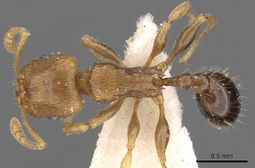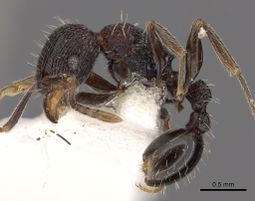Key to Afrotropical Tetramorium camerunense species group
This worker key is modified from Bolton (1980)[1], adding Tetramorium boehmei (Hita-Garcia et al., 2010)[2]. Tetramorium luteipes is also added as it was not in original key
You may also be interested in
- Tetramorium camerunense species group
- Afrotropical Tetramorium species groups
- Key to Afrotropical Tetramorium species groups
- Tetramorium
1
- Dorsal surface of postpetiole smooth or at most with faint punctulation, without rugulae or costulae. Petiole dorsum usually also smooth, rarely with faint traces of sculpture but never with a strong rugoreticulum . . . . . 2 (camerunense species complex)
- Dorsal surface of postpetiole with distinct longitudinal rugulose or costulate sculpture. Petiole dorsum with a strong rugoreticulum . . . . . 9 (lucayanum species complex)
2
return to couplet #1
- Head and alitrunk yellow or brownish yellow, the gaster usually black or at least distinctly much darker than the alitrunk . . . . . 3
- Entirety of head and body uniform dark brown to blackish brown . . . . . 5
3
return to couplet #2
- Promesonotal dorsum irregularly rugulose, forming a broken and disorganized reticulum. Petiole in dorsal view with a narrow transverse crest bordering the anterior face of the node . . . . . 3b
- Promesonotal dorsum longitudinally rugulose. Petiole in dorsal view without a transverse crest bordering the anterior face of the node . . . . . 4
3b
return to couplet #3
- Mandibles smooth ..... Tetramorium gegaimi
- Mandibles longitudinally striated ..... Tetramorium luteipes
4
return to couplet #3
- Hairs on dorsal alitrunk elongate, fine and acute apically, the longest of them greater than the maximum diameter of the eye. Rugulae of head sharply defined, the spaces between them highly polished. Promesonotal rugulae sharply defined ..... Tetramorium browni
- Hairs on dorsal alitrunk short and quite stout, blunt apically, the longest of them shorter than the maximum diameter of the eye. Rugulae of head feeble, the spaces between them densely punctulate or shagreened. Promesonotal rugulae feeble ..... Tetramorium miserabile
5
return to couplet #2
- Head and mesonotal sculpture very reduced. Head with five feeble uncomplete striations between the frontal ridges, the distance among them bigger than the striation itself. Overal aspect smooth and shining .... Tetramorium boehmei
- Head with seven or more striations between the frontal ridges, not broken and continuous from clypeal margin to cephalic dorsum, the distance among them simlar to the the striation itself . . . . . 6
6
return to couplet #5
- Rugulae of head sharply developed and strongly defined, the spaces between them very polished and without ground-sculpture ..... Tetramorium camerunense
- Rugulae of head blunted and only weakly defined, the spaces between them with a dense and conspicuous punctulate or granular ground-sculpture . . . . . 7
7
return to couplet #6
- Larger species, HW c. 0.78. Petioe node broader than long in dorsal view. Dorsal surfaces of both petiole and postpetiole with delicate punctulate sculpture ..... Tetramorium ubangense
- Smaller species, HW 0.66 at maximum. Petiole node at least as broad as long, usually longer than broad. Dorsal surfaces of petiole and postpetiole either devoid of punctulate sculpture or with only the faintest vestiges present . . . . . 8
8
return to couplet #7
- Head longer and narrower. CI 85: scapes relatively long, SI 84. Node of petiole in dorsal view much longer than broad. Pronotal dorsum with weak scattered and disorganized rugulae..... Tetramorium hapale
- Head shorter and broader. CI 88-92; scapes relatively shorter. SI 78-80. Node of petiole in dorsal view as broad as long or slightly longer than broad. Pronotal dorsum finely and densely rugulose ..... Tetramorium ictidum
9
return to couplet #1
- Anterior clypeal margin entire or the mandibles distinctly longitudinally sculptured . . . . . 10
- Anterior clypeal margin notched or impressed medially and the mandibles smooth with scattered pits or at most with extremely feeble superficial markings between the pits, not at all longitudinally striate or rugose . . . . . 11
10
return to couplet #9
- Anterior clypeal margin with a notch or impression ..... Tetramorium tychadion
- Anterior clypeal margin entire ..... Tetramorium amissum
11
return to couplet #9
- Dorsum of head with fine regular longitudinal rugulae without trace of cross-meshes, the spaces between rugulae broad and highly polished. Postpetiole with a few widely spaced weak longitudinal rugulae ..... Tetramorium lucayanum
- Dorsum of head with dense coarse irregular longitudinal rugulae with some cross-meshes present, the spaces between rugulae narrow and with strong ground-sculpture. Postpetiole coarsely longitudinally rugulose, the components dense and crowded together..... Tetramorium versiculum
References
- ↑ Bolton, B. 1980. The ant tribe Tetramoriini (Hymenoptera: Formicidae). The genus Tetramorium Mayr in the Ethiopian zoogeographical region. Bulletin of the British Museum (Natural History). Entomology. 40: 193-384
- ↑ Hita Garcia, F.; Fischer, G.; Kück, P.; Thormann, B.; Peters, M. K. 2010. Tetramorium boehmei sp. n. – a new ant (Hymenoptera: Formicidae) species from the Kakamega Forest, Western Kenya. Bonn Zoological Bulletin. 57:359-366. [2010-11]



































